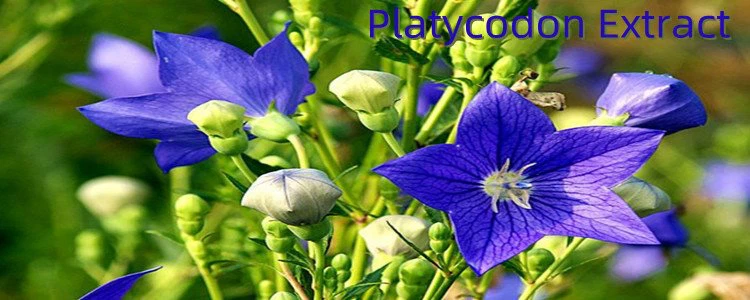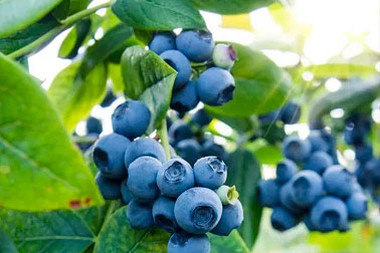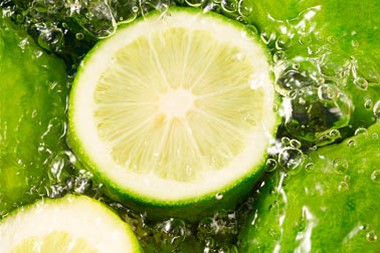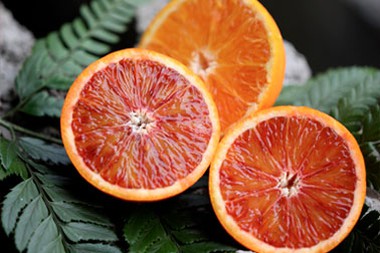Platycodon Extract, derived from the roots of the Platycodon grandiflorus plant, has been used for centuries in traditional medicine for its various health benefits. Also known as balloon flower or Chinese bellflower, it contains a wide range of bioactive compounds that contribute to its medicinal properties. In this article, we will explore its diverse applications of in promoting overall well-being and addressing specific health conditions.
Respiratory Health it has long been valued for its ability to support respiratory health. It is commonly used in traditional Chinese medicine to alleviate symptoms associated with common respiratory conditions, such as cough, bronchitis, and sore throat. The extract possesses expectorant properties, helping to loosen and expel phlegm, thus providing relief from congestion and facilitating easier breathing.
Anti-inflammatory Effects Studies have demonstrated that it possesses potent anti-inflammatory properties. It contains compounds such as saponins, flavonoids, and polyacetylenes, which exert inhibitory effects on inflammatory pathways in the body. These properties make it beneficial in managing various inflammatory conditions, including arthritis, rheumatism, and inflammatory skin disorders.
Immune System Support it has been found to enhance immune function. It stimulates the production and activity of immune cells, such as natural killer (NK) cells and macrophages, which play crucial roles in combating infections and protecting against foreign invaders. By bolstering the immune system, it may help reduce the risk of common illnesses and support overall immune health.
Digestive Health it is known for its positive effects on the digestive system. It can help alleviate digestive discomfort, including bloating, indigestion, and abdominal pain. The extract possesses carminative properties, which aid in the expulsion of gas from the gastrointestinal tract, relieving symptoms of flatulence and improving overall digestion.
Antioxidant Activity The presence of flavonoids and other antioxidants in it contributes to its potent antioxidant activity. Antioxidants help neutralize harmful free radicals in the body, reducing oxidative stress and protecting cells from damage. By scavenging free radicals, it may help prevent chronic diseases, support healthy aging, and maintain optimal cellular function.
Cardiovascular Health it has been found to have beneficial effects on cardiovascular health. It exhibits hypolipidemic properties, which means it can help lower lipid levels in the blood, including cholesterol and triglycerides. By regulating lipid metabolism, it may help reduce the risk of cardiovascular diseases, such as atherosclerosis and hypertension.
Anti-microbial Effects Studies have shown that it possesses antimicrobial properties, making it effective against various bacteria and fungi. It has been used traditionally to treat infections and promote wound healing. The extract's antimicrobial activity may provide a natural alternative to conventional antimicrobial agents in certain cases.
Anti-allergic Potential it has been investigated for its anti-allergic properties. It has shown inhibitory effects on the release of histamine, a compound involved in allergic reactions. By reducing histamine release, it may help alleviate symptoms of allergies, such as itching, sneezing, and nasal congestion.
It is important to note that while it has a long history of traditional use and promising research, further scientific studies are necessary to fully understand its mechanisms of action and potential interactions with medications. As with any herbal supplement or alternative
remedy, it is advisable to consult with a healthcare professional before using it, especially if you have underlying health conditions or are taking medications.
In conclusion, it offers a wide range of medicinal benefits, including respiratory support, anti-inflammatory effects, immune system enhancement, digestive health promotion, antioxidant activity, cardiovascular protection, antimicrobial properties, and potential anti-allergic effects. With ongoing research and scientific exploration, it may continue to gain recognition as a valuable natural remedy in supporting overall health and well-being.

What does platycodon root taste like?
Platycodon root, also known as balloon flower root or jie geng in Chinese, is a popular ingredient in traditional East Asian cuisine and herbal medicine. Derived from the perennial herb Platycodon grandiflorus, this root has a long history of use in various culinary preparations and medicinal applications. When it comes to describing its taste of it, it can be characterized as having a unique flavor profile that combines bitterness, sweetness, and a subtle hint of earthiness.
The taste of it can vary depending on how it is prepared and cooked. In its raw form, the root has a slightly bitter taste, which some people may find overwhelming. However, when properly cooked or processed, the bitterness diminishes, and other flavors emerge. It is important to note that it is often used in combination with other ingredients, and its taste can be influenced by the overall dish.
When it is cooked, the bitterness transforms into a mild sweetness, similar to that of carrots or ginseng. The sweetness adds depth to the flavor profile and helps balance out any remaining bitterness. The earthy undertones contribute to the overall taste experience, providing a subtle and grounding note to the palate.
In traditional Chinese cuisine, it is frequently used in soups, stews, stir-fries, and herbal teas. Its taste complements a wide range of ingredients, allowing it to harmonize with different flavors. The root is often combined with other herbs, vegetables, and meats to create well-rounded dishes that are both flavorful and nutritious.
The cooking method employed also affects the taste of it. Boiling or simmering the root tends to mellow its flavor, making it more delicate and less bitter. This method is commonly used in soups and herbal remedies, where the root is often simmered for an extended period to extract its beneficial properties.
Stir-frying it, on the other hand, can result in a slightly crispy texture while retaining its natural sweetness. This cooking technique adds a subtle smoky note to the root, enhancing its overall taste. Stir-fried it is often combined with other vegetables and seasonings to create flavorful side dishes or main courses.
In terms of its medicinal applications, it is believed to possess various health benefits in traditional Chinese medicine. It is commonly used to promote respiratory health, relieve coughs, and soothe sore throats. The taste of the root plays a significant role in its medicinal properties, as different tastes are associated with specific therapeutic effects according to the principles of Traditional Chinese Medicine.
In conclusion, the taste of it can be described as a combination of bitterness, sweetness, and earthiness. Its flavor profile transforms when cooked, with the bitterness giving way to a mild sweetness and the earthy undertones adding depth. Whether used in culinary preparations or herbal remedies, it contributes to a well-rounded taste experience that complements a variety of ingredients. Understanding its taste is essential for creating delicious dishes and harnessing its potential health benefits in traditional medicine.
Discovering the Native Habitat of Platycodon
Platycodon, commonly known as balloon flower, is a perennial flowering plant that belongs to the family Campanulaceae. With its vibrant blue, purple, or white blossoms, it has become a popular ornamental plant in gardens and landscapes worldwide. This article explores its native habitat of it, shedding light on its origins and the conditions that favor its growth.
Geographical Distribution
it is native to East Asia, primarily found in countries such as China, Korea, Japan, and Siberia. It thrives in the temperate regions of these countries, where it has adapted to diverse climatic conditions and soil types. Over time, it has been introduced to various parts of the world as an ornamental plant due to its attractive flowers.
Climate and Temperature
In its native range, it can be found growing in both cool and warm temperate climates. It is known to withstand cold winters and can survive in regions where temperatures drop below freezing point. However, it also tolerates warmer summers, making it adaptable to a wide range of temperature variations.
Soil Requirements
Platycodon exhibits a versatile nature when it comes to soil types. It prefers well-drained soil that is rich in organic matter. The plant can tolerate various soil pH levels, ranging from slightly acidic to slightly alkaline. This adaptability allows it to thrive in different soil conditions, making it suitable for cultivation in various regions across the globe.
Light Conditions
Platycodon requires a significant amount of sunlight to grow and bloom optimally. It favors full sun or partial shade, as these conditions promote healthy growth and encourages the development of vibrant flowers. While it can tolerate some shade, insufficient sunlight may result in reduced flower production and weaker plant growth.
Altitude and Elevation
Platycodon is often found growing at moderate to high altitudes in its native habitat. In regions like China and Korea, it can be seen growing on mountain slopes and meadows. However, it can also adapt to lower elevations and is commonly cultivated in gardens and parks across different regions worldwide.
Propagation and Cultivation
it can be propagated through both seeds and division. Seeds can be sown directly in the soil in spring or fall, while division involves separating the plant's root clumps and replanting them. It is a relatively low-maintenance plant, requiring regular watering, especially during dry periods. Fertilizing the soil with organic matter can promote healthier growth and more prolific flowering.
Ecological Significance
it not only serves as an aesthetically pleasing garden plant but also holds ecological significance. Its flowers attract pollinators like bees and butterflies, contributing to the overall biodiversity of the surrounding ecosystem. Additionally, it has been used in traditional medicine in East Asian cultures for its potential health benefits.
Conclusion
Platycodon Extract, or balloon flower, is native to East Asia, particularly China, Korea, Japan, and Siberia. It thrives in a variety of climatic conditions, including both cool and warm temperate regions. With its adaptability to different soil types and its preference for full sun or partial shade, it has become a popular ornamental plant worldwide. Its ecological significance, coupled with its attractive flowers, makes it a valuable addition to gardens and landscapes. Understanding the native habitat and growing requirements of it can help enthusiasts cultivate and appreciate this beautiful plant.
please contact us at email: selina@ciybio.com.cn



